See also Mars, Europa, Ganymedes.
Below: Voyager photograph of Titan.

|
Titan was discovered by the Dutch astronomer Christian Huygens in 1655. It was the first moon observed around Saturn.
Titan is the largest satellite of Saturn, with a diameter 6% larger than that of Mercury. Titan is by the size the second satellite of the solar system, after Ganymede. It is the only satellite known to possess a dense atmosphere.
Titan is mainly composed of rock and frozen water. Its thick atmosphere has long prevented the observation of its surface. The Cassini-Huygens mission in 2004 resulted in the discovery of liquid hydrocarbon lakes in the polar regions of the satellite. Geologically, the surface of Titan is young: some mountains as well as possible cryovolcans are observed, but the surface remains relatively flat and smooth with few impact craters observed.
The atmosphere of Titan is 98.4% dinitrogen and has 1.6% methane and ethane clouds. Climate, which includes winds and methane rains, creates surface features similar to those found on Earth, such as dunes and coasts, and, as on Earth, there are seasons. With its liquids at the surface and its thick nitrogen atmosphere, Titan is perceived as an analog of the primitive Earth, but at a much lower temperature. The satellite is cited as a possible host of extraterrestrial microbial life or, at least, as a prebiotic environment rich in complex organic chemistry.
Titan must be warm inside: it changes shape as it orbits Saturn once every 16 days. Cassini measured Titan's tidal bulging, finding the surface rising and falling on the order of 30 feet (9 meters). If Titan were completely solid, those tides would be at least 10 times less pronounced, scientists have said.
But the floor of Titan's subsurface ocean may be compacted and frozen, not warm, scientists said. It could prevent warm liquid water from receiving the complex mix of minerals necessary for life to arise, at least from below. Therefore, it is critical to know if the organic-rich surface of Titan can "communicate" with the subsurface seas.
New pictures, taken with the ground-based Keck telescope, have brought some more evidence that Titan has a dynamic weather system with clouds and thunderstorms analog to Earth's with clouds consisting of methane gas rather than water.
The pictures have a better resolution than previous pictures, and some scientists are now more convinced that the bright continent-sized area may be a large icy highland, surrounded by dark regions that could be seas of ethane or lowlands mired in tar.
The findings are published in the December 20 issue of the Astrophysical Journal. Caltech-led research on Titan is detailed in a December 19, 2002 paper, in the journal Nature.
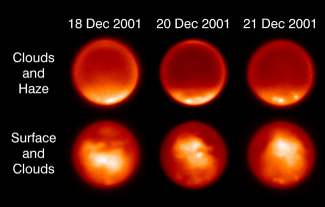 |
Above: Keck images of Titan made during three nights in December 2001. The upper row shows Titan's troposphere (lower atmosphere), which contains the newly discovered south polar methane clouds. Images in the lower row show Titan's surface rotating as well as the same methane cloud features near the south pole. CREDIT: H.G. Roe, I. de Pater, B.A. Macintosh, C.P. McKay.
Huygens will be the first space probe to land on a world in the outer Solar System. In early 2005, it will land on the surface of Titan, Saturn's largest moon, and the only moon in the Solar System to possess a thick atmosphere, 50% thicker than the Earth's atmosphere. Titan's atmosphere is indeed so thick that the surface cannot be seen in visible light. It is composed primarily of molecular nitrogen (as is Earth's) with no more than 6% argon and a few percents methane. Interestingly, there are also trace amounts of at least a dozen other organic compounds (i.e. ethane, hydrogen cyanide, carbon dioxide) and water. The organics are formed as methane, which dominates in Titan's upper atmosphere, is destroyed by sunlight. In many ways, this is similar to the conditions on Earth early in its history when life was first getting started.
Ultraviolet light from the Sun can break the methane molecules apart, leading to the formation of complex organic molecules by which scientists mean molecules containing carbon. Carbon compounds are the first step towards life, as we know it on Earth. Life, itself, is based on extremely complicated carbon molecules such as DNA. So Huygens' investigations may reveal how life began on Earth.
Jean-Pierre Lebreton, ESA's Project Scientist for Huygens says:
"One of the key questions we hope to address is how complex the organic molecules have grown in Titan's atmosphere."
Of course, organic molecules are still a long way from life itself. And scientists are still unsure about the difference between the living and the non-living. No satisfactory definition has been found so far. Any attempt to define life's characteristics either excludes some types of life or includes some inanimate objects. When looking for an appropriate definition of life, there is one property all scientists seem to agree on: all life needs energy to sustain its metabolism. For example, plants use sunlight, while animals extract energy from organic molecules in the food they eat. This happens not only in these higher-level organisms, but also in the simplest forms of life on Earth, microbes. Microbes are single-cell organisms that capture their life-energy from a dizzying array of inorganic chemical reactions. Such chemical metabolisms are so different from those in the animals and plants of Earth, that astrobiologists now wonder if life could arise in any place that can sustain a rich network of chemical reactions, such as on Titan. Moreover, on Earth, microbes have adapted to the extreme environmental conditions. This is why scientists now wonder if life could arise on Titan.
By all standards, Titan is an extreme and hostile environment to life, as we know it. Any life on Titan would have to be totally different from all Earthly forms.
Lebreton says:
"The conditions on Titan are not adequate for the kind of life we understand today. It is very cold and there is no liquid water but we should be ready for surprises."
However, there is indeed a potentially liquid environment on Titan, and there are a lot of organic compounds. The question whether Titan's interior is still hot is not solved yet.
Huygens' geological and environmental investigations, and Cassini's mapping from orbit, might record chemical anomalies or curious geological structures that warrant further investigation as possible life indicators.
Hubble Space telescope pictures have suggested that a huge bright "continent" exists on the hemisphere of Titan that faces forward in its orbit. These results do not prove that liquid "seas" exist, only that Titan has large bright and dark regions on its surface. The landing site for the Huygens probe has been chosen in part by examining these images. It will be just "offshore" of the largest "continent" at 18.1 degrees North, 208.7 degrees longitude.
Piercing the smog enshrouding Titan, new images from Cassini reveal an exotic surface covered with a variety of materials.
July 4, 2004: It didn't take long for the Cassini spacecraft to start making discoveries. In orbit around Saturn for only a few days, Cassini has already captured images of Saturn's giant moon Titan revealing never-before-seen details of the moon's surface.
"Although the initial images appear bland and hard to interpret, we're happy to report that we have indeed seen Titan's surface with unprecedented clarity," says JPL's Dennis Matson, project scientist for the international Cassini-Huygens mission.
|
Right: A false-color image of Titan. Yellow areas correspond to hydrocarbon-rich regions; green areas are icier regions. A south polar methane cloud appears white. Note the circular feature, a possible impact crater, in the northern hemisphere. |
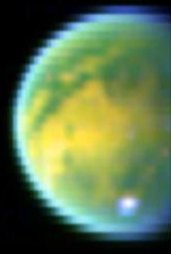
|
Titan's dense atmosphere is opaque at most wavelengths, but Cassini's visible and infrared mapping spectrometer takes pictures at wavelengths in which the atmosphere is clear. Near-infrared colors, some three times redder than the human eye can see, reveal what lies beneath the clouds.
"We're seeing a totally alien surface," says Elizabeth Turtle of the University of Arizona. "There are linear features, circular features, curvilinear features. These suggest geologic activity on Titan, but we really don't know how to interpret them yet. We've got some exciting work cut out for us."
In addition to seeing through Titan's clouds, the visual and infra-red spectrometer is also able to sense specific minerals and chemicals; this is the first time scientists have been able to map the surface-mineralogy of Titan. Using hundreds of wavelengths, many of which have never been used in Titan imaging before, they are creating a global map showing distributions of hydrocarbon-rich regions and areas of icy material.
Says JPL's Kevin Baines, Cassini science-team member: "At some wavelengths, we see dark regions of relatively pure water ice and brighter regions with a much higher amount of non-ice materials, such as simple hydrocarbons. This is different from what we expected."
Also, he adds, "a methane cloud is visible near the south pole. It's made of unusually large particles compared to Titan's typical haze particles, suggesting a dynamically active atmosphere there."

Above: This five-hour sequence of images, acquired on July 2, 2004, illustrates the evolution of a field of clouds near Titan's south pole. The bright clouds, believed to be composed of methane, appear in generally the same area where Earth-based astronomers have previously detected clouds. Cassini also saw clouds in this region during its approach to Saturn.
Since entering orbit, Cassini has also provided the first view of a vast swarm of hydrogen molecules surrounding Titan well beyond the top of Titan's atmosphere. Cassini's magnetospheric imaging instrument, first of its kind on any interplanetary mission, provided images of the huge cloud sweeping along with Titan in orbit around Saturn. The cloud is so big that Saturn and its rings would fit within it.
"The top of Titan's atmosphere is being bombarded by highly energetic particles in Saturn's radiation belts, and that is knocking away this neutral gas," explains Stamatios Krimigis of the Johns Hopkins Applied Physics Laboratory, principal investigator for the magnetospheric imager. "In effect, Titan is gradually losing material from the top of its atmosphere, and that material is being dragged around Saturn."
Right: Surrounding Titan, a globular cloud of gas some 70,000 kilometers (43,496 miles) in diameter.
These first images of Titan and its environs are just a taste of what's to come. "We look forward to future, much closer flybys and use of radar for much greater levels of surface detail," notes Dennis Matson.
The study of Titan, Saturn's largest moon, is one of the major goals of the Cassini-Huygens mission. Titan may preserve in deep-freeze many chemical compounds that preceded life on Earth. Friday's flyby at a closest distance of 339,000 kilometers (210,600 miles) provided Cassini's best look at Titan so far, but over the next four years, the orbiter will execute 45 Titan flybys as close as approximately 950 kilometers (590 miles). This will permit high-resolution mapping of the moon's surface with an imaging radar instrument, which can see through the opaque haze of Titan's upper atmosphere.
In January 2005, the Huygens probe that is now attached to Cassini will descend through Titan's atmosphere to the surface.
Credits and Contacts
Source: NASA press release
Responsible NASA official: Ron Koczor
Production Editor: Dr. Tony Phillips
Curator: Bryan Walls
Media Relations: Steve Roy
Original web page:
http://science.nasa.gov/headlines/y2004/04jul_titanrevealed.htm?list1049228
Titan is the fifteenth of Saturn's known satellites and the largest:
| Orbit: | 1,221,830 km from Saturn |
|---|---|
| Diameter: | 5150 km |
| Mass: | 1.35e23 kg |
| Atmosphere density: | 1.5 bar (50% more dense than Earth atmosphere) |
| Period (days): | 15.95 |
NASA publishes a radar surface scan in their Photojournal:
http://photojournal.jpl.nasa.gov/jpeg/PIA06992.jpg
ESA publishes this new false colors image photograph:
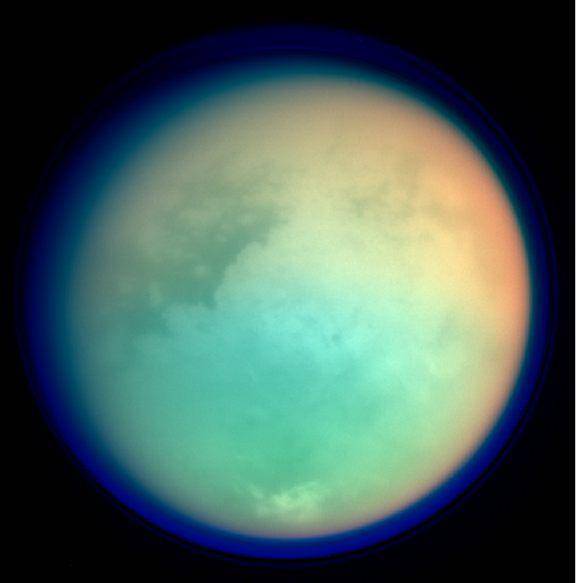
|
Source ESA, http://www.esa.int/SPECIALS/Cassini-Huygens/SEMIRJ0A90E_0.html
The first images taken on landing by the ESA probe Huygens on January 14, 2005:
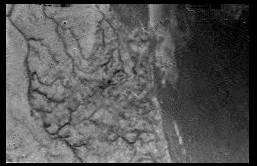
|
Above: One of the first raw images among 300, it was taken from an altitude of 16.2 kilometers with a resolution of approximately 40 meters per pixel during the probe's descent. ESA said: "It apparently shows short, stubby drainage channels leading to a shoreline."
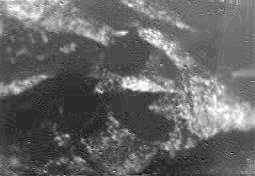
|
Above: Taken at an altitude of 8 kilometers with a resolution of 20 meters per pixel. ESA Said: "It shows what could be the landing site, with shorelines and boundaries between raised ground and flooded plains."
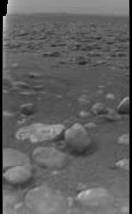
|
Above: Raw image by the DISR camera after the probe descended through the atmosphere of Titan. It shows the surface with ice blocks strewn around. ESA indicates that the size and distance of the blocks will be determined when the image is properly processed.
Source ESA, http://www.esa.int
Huygens landed after an unexpectedly bumpy ride though the atmosphere at what appears to be the shoreline of a large body of liquid, probably liquid methane. The landing spot appears to be a rough frozen terrain just yards off the shoreline, seeming to be a thin hard crust over a softer, mud-like terrain.
Titan's surface is clearly varied, showing mountains, shorelines, liquid erosion, and rivers carved by some yet undetermined liquid.
The scientists at ESA are currently trying to determine the exact spot where the probe landed, the wind speed, and the chemical composition of the atmosphere.
One scientist commented that the door is left open for the possibility of exotic life forms on the extremely cold moon, because the surface of Titan has been geologically active and may still be active today.
"It looks fresh," he said. "There aren't craters or things you would associate with a surface that's now dead."
The drainage channels on Titan's surface don't appear to be filled with liquid today. At minus 290 degrees, ordinary water would stay frozen. But the heat produced from intense geologic activity, like volcanic eruptions, could melt water for fleeting periods of time, he said. Gravity pull from nearby Saturn may play a part too, and all that may create moments for dormant extremophiles to become active, if there are any, I add. The probe is not equipped to check for signs of life.
Most scientists comment enthusiastically that it is all "fantastic", "amazing", "puzzling" and that it will take years to be more specific.
For years, Titan was thought to have a young surface with barely a mark or wrinkle to show its true age. Recent close-up views provided by Cassini instruments show that Titan is nearly as flawless as it seems from a distance, with only two impact craters found so far. Astrobiology Magazine, on May 25, 2005, commented: "A world with a more youthful surface may be more likely to harbor life."
Scientists are intrigued by an unusual bright spot on Titan. The spot is approximately 480 kilometers wide and located just southeast of the bright region nicknamed Xanadu. It has been detected by three different instruments on the Cassini spacecraft in 2005.
Involved scientists suspect it may be a hot spot, possibly an area warmed by a recent asteroid impact or by a mixture of water ice and ammonia from a warm interior, oozing out of an ice volcano onto colder surrounding terrain.
Other possibilities for the unusual bright spot include landscape features holding clouds in place or unusual materials on the surface.
Up to now scientists considered totally unlikely that Titan hosts life because ground temperature is -178°C there, which should prevent any efficient chemical reactions necessary for life. But with new data on Titan and discoveries about extreme organisms on Earth, they now speculate that some places on Titan could harbor life.
A team of researchers from Southwest Research Institute (SwRI) and Washington State University have now presented a paper at the Division for Planetary Sciences 2005 Meeting. They write that several key requirements for life now appear to be present on Titan, including liquid reservoirs, organic molecules and ample energy sources.
Methane clouds and surface characteristics strongly imply the presence of an active global methane cycle analogous to Earth's hydrological cycle. Though it is not proven that life can exist in liquid methane, such chemical schemes have been postulated. Abundant hints of ice volcanism on Titan suggest that liquid water mixed with ammonia may exist near the surface.
The team suggests that acetylene, which is abundant, could be used by organisms, in reaction with hydrogen gas, to release vast amounts of energy that could be used to power metabolism. Such a biosphere would be, at least indirectly, solar-powered.
Lead author David H. Grinspoon, a staff scientist in the SwRI Space Science and Engineering Division, said:
"One promising location for habitability may be hot springs in contact with hydrocarbon reservoirs. There is no shortage of energy sources because energy-rich hydrocarbons are constantly being manufactured in the upper atmosphere, by the action of sunlight on methane, and falling to the surface."
On sun energy, he said that "the energy released could even be used by organisms to heat their surroundings, helping them to create their own liquid cryoenvironments. In environments that are energy-rich but liquid-poor, like the near-surface of Titan, natural selection may favor organisms that use their metabolic heat to melt their own watering holes.
The team says these ideas are quite speculative but useful in that they force researchers to question the definition and universal needs of life, and to consider the possibility that life might evolve in very different environments.
Quite stunning ideas are issued in 2010 about Titan by exobiologists.
One report about it is on the website of the French popular science magazine Science et Avenir for June 2010 at:
http://www.sciencesetavenir.fr/actualite/espace/20100608.OBS5203/de-la-vie-sur-titan.html
under the title "Life on Titan?"
The article says that the Cassini probe discovered on Titan on the one hand a lack of acetylene, and on the other hand that hydrogen "disappears close to surface".
Coincidentally, Chris McKay, of NASA, and Heather R. Smith, of the International Space University in Strasbourg, had indeed proposed in 2005 that life forms could populate the vast hydrocarbon lakes located close to the poles of Titan, that these microbes would not breathe oxygen but hydrogen and would draw most of their energy acetylene molecules.
This precisely is what was observed, and this would have caused "agitation in the (very small) world of the astrobiologists" and "excitement" of "some specialists in the extraterrestrial life" while another said that "the biological explanation can be only the last choice after all the non-biological assumptions are dismissed", which does not seem to be possible without a new mission towards Titan to collect other data.
What strikes me most in this story is that in theory, the extremely low temperatures on Titan cannot permit life. Titan was usually described like an "Earth in the freezer", where the atmosphere and materials for life are present, but where the temperature would exclude life. Why do people then consider life possible all the same Titan? Isn't the same argument of the low temperature often used to discard life on Mars, where the temperatures range between -60°C and +15°C, highly more comfortable for life compared to the some -179°C on Titan? Do we now need to consider that life does not really need liquid water? Do we have to extend the famous "habitable zone" around other stars to much more tolerant values?
Aug 7, 2017
NASA scientists have definitively detected the chemical acrylonitrile in the atmosphere of Saturn's moon Titan, a place that has long intrigued scientists investigating the chemical precursors of life.
On Earth, acrylonitrile, also known as vinyl cyanide, is useful in the manufacture of plastics. Under the harsh conditions of Saturn's largest moon, this chemical is thought to be capable of forming stable, flexible structures similar to cell membranes. Other researchers have previously suggested that acrylonitrile is an ingredient of Titan's atmosphere, but they did not report an unambiguous detection of the chemical in the smorgasbord of organic, or carbon-rich, molecules found there.
Now, NASA researchers have identified the chemical fingerprint of acrylonitrile in Titan data collected by the Atacama Large Millimeter/submillimeter Array (ALMA) in Chile. The team found large quantities of the chemical on Titan, most likely in the stratosphere - the hazy part of the atmosphere that gives this moon its brownish-orange color.
"We found convincing evidence that acrylonitrile is present in Titan's atmosphere, and we think a significant supply of this raw material reaches the surface," said Maureen Palmer, a researcher with the Goddard Center for Astrobiology at NASA's Goddard Space Flight Center in Greenbelt, Maryland, and lead author of a July 28, 2017, paper in Science Advances.
The cells of Earth's plants and animals would not hold up well on Titan, where surface temperatures average minus 290 degrees Fahrenheit (minus 179 degrees Celsius), and lakes brim with liquid methane.
In 2015, university scientists tackled the question of whether any organic molecules likely to be on Titan could, under such inhospitable conditions, form structures similar to the lipid bilayers of living cells on Earth. Thin and flexible, the lipid bilayer is the main component of the cell membrane, which separates the inside of a cell from the outside world. This team identified acrylonitrile as the best candidate.
Those researchers proposed that acrylonitrile molecules could come together as a sheet of material similar to a cell membrane. The sheet could form a hollow, microscopic sphere that they dubbed an "azotosome." This sphere could serve as a tiny storage and transport container, much like the spheres that lipid bilayers can form.
"The ability to form a stable membrane to separate the internal environment from the external one is important because it provides a means to contain chemicals long enough to allow them to interact," said Michael Mumma, director of the Goddard Center for Astrobiology, which is funded by the NASA Astrobiology Institute. "If membrane-like structures could be formed by vinyl cyanide, it would be an important step on the pathway to life on Saturn's moon Titan."
The Goddard team determined that acrylonitrile is plentiful in Titan's atmosphere, present at concentrations up to 2.8 parts per billion. The chemical is probably most abundant in the stratosphere, at altitudes of at least 125 miles (200 kilometers). Eventually, acrylonitrile makes its way to the cold lower atmosphere, where it condenses and rains out onto the surface.
The researchers calculated how much material could be deposited in Ligeia Mare, Titan's second-largest lake, which occupies roughly the same surface area as Earth's Lake Huron and Lake Michigan together. Over the lifetime of Titan, the team estimated, Ligeia Mare could have accumulated enough acrylonitrile to form about 10 million azotosomes in every milliliter, or quarter-teaspoon, of liquid. That's compared to roughly a million bacteria per milliliter of coastal ocean water on Earth.
The key to detecting Titan's acrylonitrile was to combine 11 high-resolution data sets from ALMA. The team retrieved them from an archive of observations originally intended to calibrate the amount of light being received by the telescope array.
In the combined data set, Palmer and her colleagues identified three spectral lines that match the acrylonitrile fingerprint. This finding comes a decade after other researchers inferred the presence of acrylonitrile from observations made by the mass spectrometer on NASA's Cassini spacecraft.
"The detection of this elusive, astrobiologically relevant chemical is exciting for scientists who are eager to determine if life could develop on icy worlds such as Titan," said Goddard scientist Martin Cordiner, senior author on the paper. "This finding adds an important piece to our understanding of the chemical complexity of the solar system."
ALMA, an international astronomy facility, is a partnership of the European Organisation for Astronomical Research in the Southern Hemisphere, the U.S. National Science Foundation and the National Institutes of Natural Sciences of Japan in cooperation with the Republic of Chile.
References
Source for the above article: